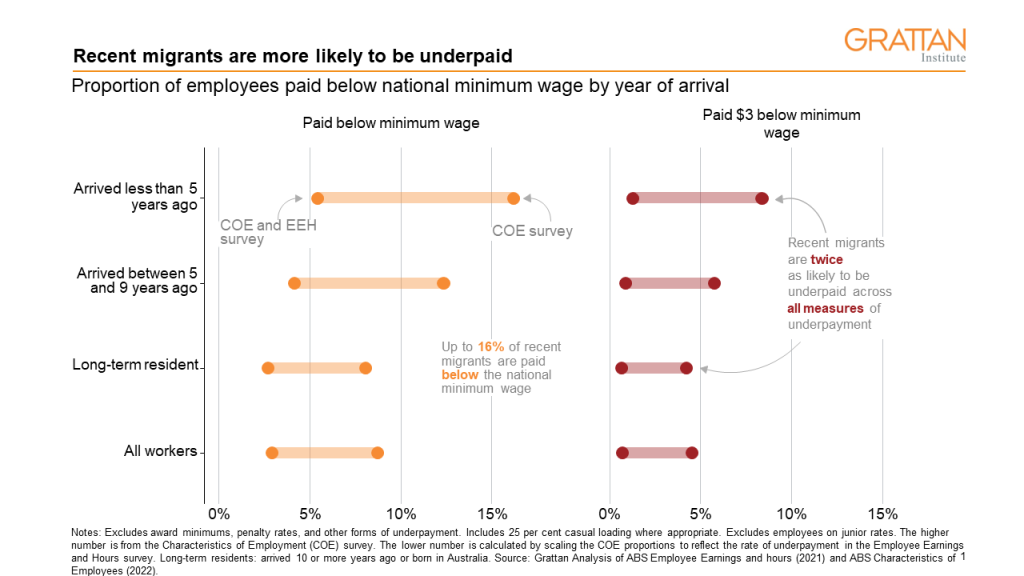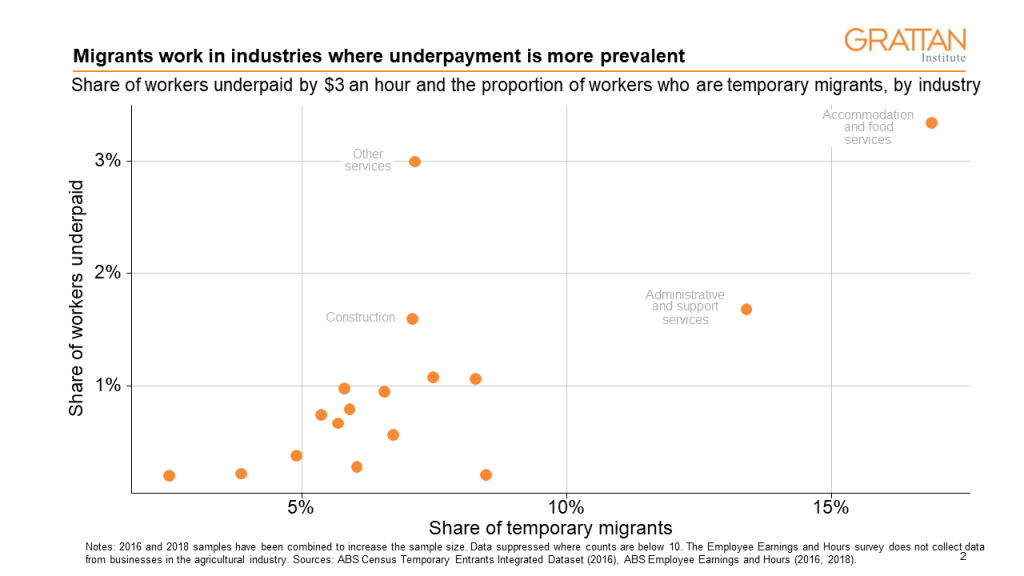Why migrant workers are more likely to be underpaid
by Brendan Coates, Trent Wiltshire, Tyler Reysenbach
From working 20 to 30 hours of unpaid overtime each week in one of Australia’s fanciest restaurants to picking fruit while being exposed to dangerous chemicals for less than $10 an hour, the underpayment of migrant workers is rife.
The Grattan Institute’s new report, Short-changed: How to stop the exploitation of migrant workers in Australia, show a broad pattern.
We’ve used two nationally representative Australian Bureau of Statistics surveys of employees and employers – Characteristics of Employment and Employee Earnings and Hours – to find out whether employees are paid below the national minimum hourly wage in Australia, currently $21.38 an hour or $26.73 an hour for casuals.
We estimate that recent migrants – those who arrived in Australia within the past five years – are twice as likely to be underpaid as migrants who have been in Australia for at least 10 years, and those born here.
Underpayment is widespread
In 2022, 5% to 16% of employed recent migrants were paid less than the national minimum wage. Between 1% and 8.5% of recent migrants were paid at least $3 less than the hourly minimum.

This compares with 3% to 9% of all employees in Australia being paid below the national minimum wage; with 0.5% to 4.5% paid at least $3 an hour less.
These numbers are likely to under-represent the extent of underpayment because our analysis only counts those being paid less than the national minimum wage.
It does not count cases where workers are underpaid against appropriate award rates, which typically pay more than the national minimum wage, penalty rates, or are not paid their superannuation.
Factors contributing to exploitation
Part of reason recent migrants are more likely to be underpaid is because they tend to work in industries where underpayment is more prevalent, such as hospitality and agriculture.
For example, temporary visa holders account for nearly 20% of workers in hospitality, the industry with the highest reported rate of underpayment.

Migrants also tend to be younger workers. Employees aged 20 to 29 are nearly six times more likely to be paid less than the national minimum wage than workers aged 30 to 39.
But even after accounting for age, industry and other demographic characteristics, migrants are still more likely to be underpaid.
Migrants who arrived in the past five years are 40% more likely to be underpaid than long-term residents with similar skills working in the same job with the same characteristics. Migrants who arrived five to nine years ago are 20% more likely to be underpaid.

Several things explain this.
First are visa rules, which make temporary visa holders more vulnerable to exploitation. For example, many international students put up with mistreatment for fear their visa may be cancelled for working more hours than permitted by their visa rules. Two-thirds of recent migrants are on a temporary visa.
Migrants have less bargaining power than local workers, partly because they have small social networks to help them find a job. They may not know what workplace rights they are entitled to and face discrimination in the labour market.
Our analysis shows the likelihood of underpayment is also higher among those working less-skilled jobs with fewer qualifications.
Without change, underpayment will rise again
Rates of underpayment for migrant workers and locals alike have fallen since the pandemic began
In 2018, 8% to 22% of recent migrants were paid less than the minimum hourly wage (compared with 5% to 16% in 2022).
This probably reflects the decline in the number of temporary visa holders living in Australia, especially students and working holiday makers, and labour shortages boosting worker’s bargaining power.
But with borders open again and temporary visa holders coming back in big numbers, the rate of underpayment seems sure to rise again without action from government to stamp out exploitation.
The federal government needs to reform the visa rules that make migrants vulnerable, boost resources to enforce workplace and migration laws and make it easier for migrants to claim money owed.
Underpayment has been widespread for too long. Now is the time to put a stop to it.
Brendan Coates
Trent Wiltshire
While you’re here…
Grattan Institute is an independent not-for-profit think tank. We don’t take money from political parties or vested interests. Yet we believe in free access to information. All our research is available online, so that more people can benefit from our work.
Which is why we rely on donations from readers like you, so that we can continue our nation-changing research without fear or favour. Your support enables Grattan to improve the lives of all Australians.
Donate now.
Danielle Wood – CEO
